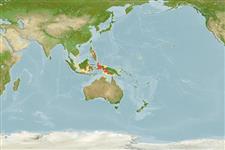Classification / Names
ชื่อสามัญ | ชื่อพ้อง | Catalog of Fishes(สกุล, ชนิด) | ITIS | CoL | WoRMS | Cloffa
>
Eupercaria/misc (Various families in series Eupercaria) >
Labridae (Wrasses)
Etymology: Paracheilinus: Greek, para = the side of + Greek, chaite = hair + Greek, odous = teeth (Ref. 45335); nursalim: Named for Sjamsul and Itjih Nursalim; noun in apposition..
Environment: milieu / climate zone / depth range / distribution range
นิเวศวิทยา
เกี่ยวกับทะเล,น้ำเค็ม เกี่ยวกับหินโสโครก; ระดับความลึก 5 - 50 m (Ref. 74967), usually 20 - 35 m (Ref. 74967). Tropical
Western Pacific: New Guinea, Indonesia.
ขนาด / น้ำหนัก / Age
Maturity: Lm ? range ? - ? cm
Max length : 5.1 cm SL เพศผู้/กระเทย; (Ref. 74967); 2.9 cm SL (female)
Short description
สัณฐานวิทยา | ความยาวต่างๆ
เงี่ยงครีบหลัง (รวม): 8 - 9; ก้านครีบอ่อนที่หาง (รวม): 11; เงี่ยงครีบก้น 3; ก้านครีบอ่อนที่ก้น: 8 - 10. This species is distinguished by the following set of characters: pored lateral-line scales 11-16+3-10, often 16+5-7; gill rakers usually 12-13 (sometimes 14-15); body depth 2.9-3.5 in SL; often, 4-6 (rarely 3) dorsal soft rays of males prolonged as narrow, tapering filaments that are erected during courtship; in males, caudal fin strongly lunate, the length 1.6 (1.7-2.4) in SL and caudal concavity 0.8-1.5 in HL; pelvic fins 1.6-1.8 in males and 2.0-2.2 in females, both in HL; live colour of male differs from all other Paracheilinus in having a pair of rectangular blackish patches, one on ventral half of caudal peduncle and adjacent body, and the other, often less distinct, on upper back, below middle of spinous dorsal fin. Similar to P. cyaneus in general appearance; sympatric throughout its known range (Misool, Fak Fak Peninsula, and Triton Bay area). The two species are easily distinguished on the basis of male coloration, particularly that associated with courtship displays (Ref. 74967).
Inhabits semi-sheltered areas, exposed to periodic strong currents; invariably associated with gradual rubble slopes at depths ranging from about 5-50 m or more, but most abundant between about 20 and 35 m. Large aggregations, of about 30 males and several hundred females, were occasionally encountered in only 6 to 10 m at Triton Bay (Ref. 74967).
Life cycle and mating behavior
วัยเจริญพันธุ์ | การสืบพันธุ์ | การวางไข่ | เซลสืบพันธ์ของเพศเมีย(ไข่) | ความดกของไข่ | ตัวอ่อน
Oviparous, distinct pairing during breeding (Ref. 205).
Allen, G.R. and M.W. Erdmann, 2008. Paracheilinus nursalim, a new species of flasher wrasse (Perciformes: Labridae) from the Bird's Head Peninsula of western New Guinea with a key to the species of Paracheilinus,. aqua, Int. J. Ichthyol. 13(3-4):179-188. (Ref. 74967)
IUCN Red List Status (Ref. 130435)
Threat to humans
Harmless
Human uses
ข้อมูลเพิ่มเติม
ชื่อสามัญชื่อพ้องกลไกการเผาผลาญพลังงานผู้ล่าการศึกษาเกี่ยวกับผลกระทบของสารประกอบทางเคมีที่เป็นอันตรายต่อสิ่งมีชีวิต ประชากร และสิ่งแวดล้อมการสืบพันธุ์วัยเจริญพันธุ์การวางไข่การรวมกลุ่มวางไข่ความดกของไข่เซลสืบพันธ์ของเพศเมีย(ไข่)Egg development
Age/SizeการเจริญเติบโตLength-weightLength-lengthLength-frequenciesความยาวต่างๆสัณฐานวิทยาตัวอ่อนพลวัตของสัตว์น้ำวัยอ่อนการทดแทนที่อุดมสมบรูณ์BRUVS
อ้างอิงการเพาะเลี้ยงสัตว์น้ำประวัติการเพาะเลี้ยงสัตว์น้ำสายพันธุ์พันธุศาสตร์ElectrophoresesอัตราพันธุกรรมโรคการแปรรูปNutrientsMass conversion
ผู้ร่วมมือรูปภาพหลายรูปStamps, Coins Misc.เสียงปลามีพิษ เช่น ปลาปักเป้าความเร็วรูปแบบการว่ายน้ำพื้นที่เหงือกOtolithsสมองวิสัยทัศน์
เครื่องมือ
Special reports
Download XML
แหล่งที่มาจากอินเตอร์เน็ต
Estimates based on models
Preferred temperature (Ref.
123201): 27.9 - 29, mean 28.3 °C (based on 32 cells).
Phylogenetic diversity index (Ref.
82804): PD
50 = 0.5000 [Uniqueness, from 0.5 = low to 2.0 = high].
Bayesian length-weight: a=0.00955 (0.00456 - 0.02002), b=3.06 (2.89 - 3.23), in cm total length, based on LWR estimates for this (Sub)family-body shape (Ref.
93245).
ระดับชั้นอาหาร (Ref.
69278): 3.3 ±0.4 se; based on size and trophs of closest relatives
ความสามารถในการกลับคืนสู่ปกติ (Ref.
120179): ความสูง, เวลาต่ำสุดที่จะทำให้ประชากรเพิ่มขึ้นเป็น 2 เท่าใช้เวลาน้อยกว่า 15 เดือน (Preliminary K or Fecundity.).
Fishing Vulnerability (Ref.
59153): Low vulnerability (10 of 100).
Nutrients (Ref.
124155): Calcium = 181 [102, 412] mg/100g; Iron = 1.21 [0.66, 2.41] mg/100g; Protein = 18.1 [15.1, 20.3] %; Omega3 = 0.192 [0.099, 0.360] g/100g; Selenium = 24.2 [11.5, 51.5] μg/100g; VitaminA = 293 [85, 1,131] μg/100g; Zinc = 2.39 [1.48, 3.85] mg/100g (wet weight);
